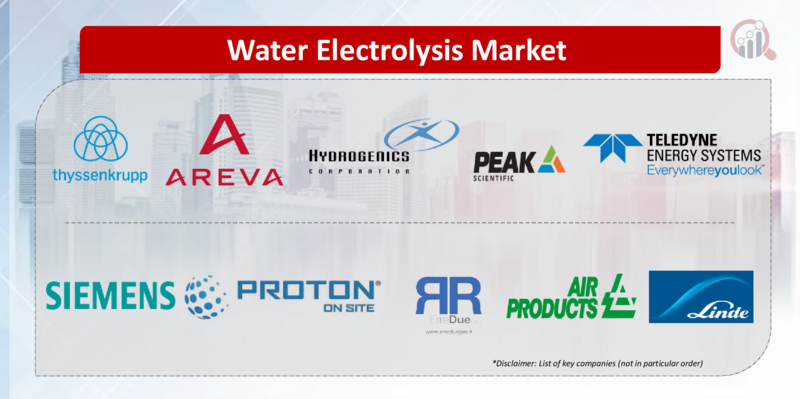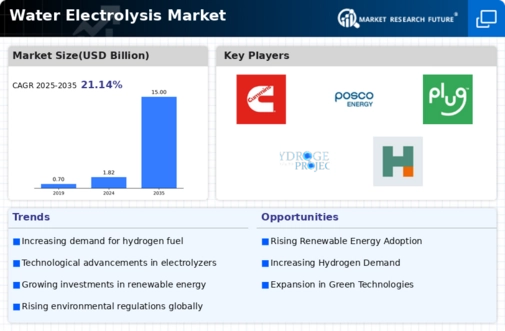Top Industry Leaders in the Water Electrolysis Market

*Disclaimer: List of key companies in no particular order
Top listed global companies in the industry are:
- ThyssenKrupp AG
- Linde AG
- Air Products and Chemical Inc.
- Siemens AG
- ProtonOnsite
- Teledyne Energy Inc.
- AREVA H2Gen
- Hydrogenics Corporation
- Erre Due SpA
- Peak Scientific, among others
Electrifying the Market: Navigating the Competitive Landscape of Water Electrolysis
The global water electrolysis market is a rapidly evolving arena where players vie for control over clean hydrogen generation. Understanding the strategies powering this electrifying competition, the factors shaping market share, and emerging trends is crucial for navigating this dynamic landscape.
Key Players and their Strategies:
- Established Giants: Global players like ThyssenKrupp and Air Products leverage their extensive experience, engineering prowess, and brand recognition to maintain a leading position. ThyssenKrupp offers large-scale alkaline and PEM electrolyzers, while Air Products excels in large-scale proton exchange membrane (PEM) technology.
- Regional Specialists: Companies like McPhy and Proton OnSite focus on specific regions and applications. McPhy caters to Europe's growing demand for renewable hydrogen with its innovative alkaline and PEM electrolyzers, while Proton OnSite excels in modular PEM systems for on-site hydrogen generation.
- Innovative Upstarts: Startups like Nel Hydrogen and ITM Power disrupt the market with fresh approaches. Nel Hydrogen focuses on cost-effective alkaline electrolyzers for large-scale applications, while ITM Power pushes the boundaries with high-efficiency PEM electrolyzers utilizing anion exchange membranes (AEM).
Factors for Market Share Analysis:
- Technology Maturity and Cost: Offering proven and cost-effective technologies like alkaline electrolyzers holds weight in price-sensitive markets, while advanced PEM or AEM technologies with higher efficiency attract premium pricing.
- Project Capacity and Scalability: Providing large-scale electrolyzer solutions for industrial hydrogen production caters to specific segments, while modular and scalable systems for on-site generation attract distributed applications.
- Green Hydrogen Focus: Demonstrating commitment to clean hydrogen production using renewable electricity and sustainable practices resonates with environmentally conscious customers.
- After-Sales Service and Support: Offering comprehensive after-sales support, including maintenance, spare parts, and technical expertise, fosters customer loyalty and market penetration.
Emerging Trends and Company Strategies:
- Electrolyzer Stack Innovation: Developing next-generation electrolyzer stacks with higher efficiency, durability, and lower capital costs is a top priority. ITM Power's AEM technology exemplifies this trend.
- Integration with Renewables: Integrating electrolyzers directly with renewable energy sources like wind and solar farms facilitates seamless green hydrogen production. McPhy's renewable hydrogen solutions exemplify this approach.
- Electrolyzer Stack Standardization: Standardizing key components and interfaces across stack designs streamlines manufacturing, reduces costs, and accelerates market adoption. Nel Hydrogen's standardized stack modules exemplify this.
- Focus on Specific Applications: Targeting high-growth segments like transportation, power generation, and industrial feedstock with tailored electrolyzer solutions is a growing trend. Air Products' catering to hydrogen fueling stations exemplifies this approach.
Overall Competitive Scenario:
The water electrolysis market presents a dynamic landscape where established players face challenges from regional specialists and innovative startups. Success hinges on offering a balance of mature and advanced technologies, catering to diverse project sizes and applications, prioritizing clean hydrogen production, and providing comprehensive support. Companies demonstrating agility, cost-effectiveness, and a commitment to innovation and sustainability hold a strong hand in navigating this electrifying market transformation.
Latest Company Updates:
November 2023:
A peer-reviewed publication in Nature Communications today describes the development of an innovative and rechargeable device—an electrocatalytic on-site oxygenator (ecO2)—by Rice University and its Biotech Launch Pad. This device generates oxygen to sustain cells within an implantable "living pharmacy," which may have a positive impact on the efficacy of cell-based therapies. The Rice Biotech Launch Pad is currently developing an implantable "living pharmacy" designed to administer and regulate therapeutics autonomously within an individual. On the website of Nature Communications, the article titled "Electrocatalytic on-site oxygenation for transplanted cell-based therapies" is available for viewing. This revolutionary technology possesses the capacity to fundamentally alter the terrain of disease treatment and the trajectory of scientific inquiry and advancement in the domain of cell-based therapies. In order to bring this technology one step closer to those in need, we are striving to integrate it into clinics.
February 2023:
China Petroleum and Chemical Corporation Sinopec recently initiated its inaugural green hydrogen demonstration initiative in the Inner Mongolia Autonomous Region, dedicating an investment of $828 million. It is anticipated that the "Inner Mongolia Erdos wind-solar green hydrogen project" will contribute approximately 87.17 million ¥ to the country's gross domestic product and reduce carbon emissions by 1.43 million tons annually. Power transmission and transformation, wind and photovoltaic energy generation, hydrogen production via water electrolysis, hydrogen storage, and transportation are all encompassed within the scope. The wind and solar power installations are anticipated to attain capacities of 450 MW and 270 MW, correspondingly. The annual hydrogen production capacity through water electrolysis is anticipated to be 30,000 tons, while the hydrogen storage capacity will attain 288,000 standard cubic meters.









